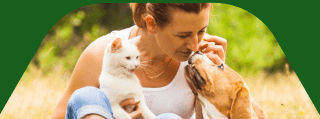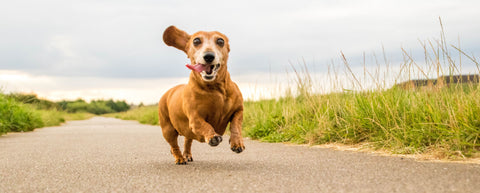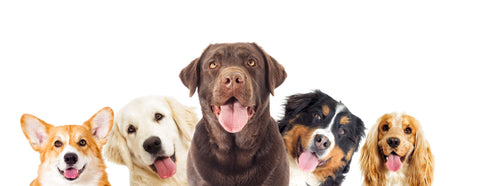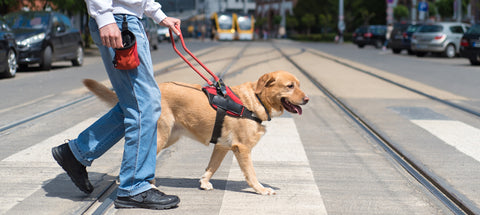With dog agility becoming more popular every year, preventing injuries in canine athletes has become a hot topic with anyone involved in dog sports. Once you and your pooch are hooked on training and you’ve worked hard to build a brilliant bond on that obstacle course, the last thing you want is an injury that stops your four-legged friend in their tracks. So, let’s take a look at ways you can protect your dog – whether they’re involved in work, sports, competition or just for fun – and prevent them from sustaining an injury.
What is agility training for dogs?
When it comes to injuries, our precious pups aren’t so different to ourselves. If they do agility sports without proper training, or just over-exert themselves when they’re exercising, they’re at risk of getting injured and having to hit pause on doing what they love.
To prevent injuries in agility dogs, it’s important to first be sure that agility training is well suited to your pooch. Dog agility involves directing your dog through an obstacle course within a certain timeframe, so it’s ideal for very energetic, agile dogs. In the competitive version of these events, dogs compete against others, so confidence and socialization is also key. But you can also take dog agility classes for fun, and practice in your own home.
Part of the beauty of agility training is the incredible bond it builds between you and your dog. It’s very much a joint effort between the two of you. You’ll guide your pooch around a range of tricky obstacle courses with a mixture of cues and body language, so very intuitive dogs will also ace this sport.
What about other sports for dogs?
Agility is just one of many sports that active dogs love to get involved with, and although there’s usually a competitive element, these sports can also be enjoyed just for fun.
Flyball, for example, is a sport that any breed or size of dog can do. Participants race over a line of hurdles to a box that releases a tennis ball when the dog presses the spring-loaded pad. The dog catches the ball, then carries it back to their handler – oftentimes with a wagging tail!
Bikejoring and nosework are two more examples of popular dog sports that get the adrenaline going and allow your dog to use their natural instincts. When it comes to preventing injuries, our advice applies to all canine athletes, regardless of which particular sport your dog enjoys.
How do I stop my agility dog getting injured?
Once you’ve gotten started in a sport that suits your dog’s age, breed and temperament, and discovered they have a real flair for it, you’re going to want to do everything you can to prevent having to duck out due to injury. Let’s take a look at some of the ways you can keep your agility dog safe from injury, so they can carry on doing what they love most.

Get a health screening beforehand
Before you sign your dog up for competitive sports, it’s worth getting a pre-sport health screening from your veterinarian. That way they can check for any underlying issues that might be triggered, or that might lead to injury further down the line – whether that’s an issue with your dog’s gait or a problem with their shoulders that you’d only spot on an x-ray.
Warm your dog up properly
Although many trainers, owners and handlers skip a warm-up before training and trials, it’s so important to build this into your routine. Reason being, a warmed-up muscle is more flexible and can withstand strain much more than a ‘cold’ muscle can. By raising your dog’s core body temperature – just by a couple degrees – you’re raising their heart rate and increasing the blood flow through their body, which gets their body ready to start training.
Aim to build 15 minutes of warm-up time into your routine, starting gently and gradually building up to activities and tasks similar to what they’ll be doing on the course. The aim here isn’t to tire your dog out, but to get them ready to complete, rather than expecting them to go from zero to full-throttle in a blink.
Stick to age-appropriate training
Starting a training program too early can cause life-long injuries to your dog’s bones and joints, so if you have a puppy you’ll need to stick to training that’s tailored to their age. A puppy’s soft growth plates are vulnerable to injury until they close, so don’t introduce high-intensity activity until your veterinarian tells you the time is right.
Likewise, older dogs will need a training schedule that’s tailored to them, and which doesn’t cause over-exertion. You could also add a joint health supplement to their diet to protect them from wear and tear and improve mobility.
Feed your dog the right nutrition
As well as joint supplements, you’ll need to look carefully at your dog’s diet if you’re planning to take agility seriously. The American Kennel Club has an excellent blog on the best nutrition for dog shows and dog sports, including some great advice specifically for dog agility trials.
Keep them safe on the course
It sounds super basic, but make sure the course your dog is completing is safe. That means checking for things like slippery or uneven surfaces, and making sure your dog trains on a variety of different surfaces so they’re not caught out.
If you’re trying out dog agility at home in the back yard, you’ll need to be extra careful here, making sure that any obstacle courses you create don’t have the potential to cause your dog an injury.
Mix it up with cross-training
Don’t just stick to the same old tried-and-tested exercise routines. Mix it up with different types of activities and your dog will not only find it more stimulating and fun, but their performance will likely come on leaps and bounds, too. That means walks, runs, swimming, hiking – you name it. On the other hand, don’t forget to build in plenty of time for rest, as proper recuperation is just as important.
Let your agility dog cool down properly
Speaking of recuperation, don’t underestimate how important it is for your agility dog to cool down after an energetic trial. They’ll need time to wind down slowly and reduce their heart rate gradually, so you could start with a trot, slow to a walk, and finally reduce to a slow walk over the course of 10-20 minutes directly after a competition.
In the same vein, don’t hesitate to get a suspected injury checked out if you’re concerned. You might first notice your dog isn’t performing as well as usual, for example, or that they seem reluctant to do a specific task. Early diagnosis from a veterinarian can avoid a simple strain becoming an ongoing condition, so take your dog’s cues and get things checked out right away.

A final word on preventing injuries in agility dogs
Agility is a brilliant sport that builds an unbreakable bond between you and your four-legged friend, whether you’re competing seriously, or taking a class just for fun. By taking steps to keep your beloved pooch safe from harm, you can keep building that bond and enjoying the time being active together. We’ll see you on the agility course soon!










